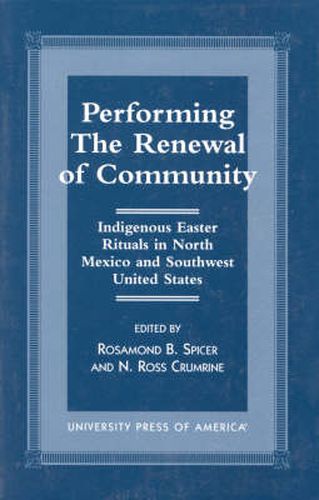Readings Newsletter
Become a Readings Member to make your shopping experience even easier.
Sign in or sign up for free!
You’re not far away from qualifying for FREE standard shipping within Australia
You’ve qualified for FREE standard shipping within Australia
The cart is loading…






Anthropologists-as well as the Yaquis and many of the other indigenous peoples of Mexico and of Latin America in general-have recognized the intense and penetrating symbolism which is ritualized in the Easter dramas. This book is about the role of the Easter rituals in the Yaqui way of life in both Arizona and Sonora. It contains detailed ethnographic descriptions of these ceremonies. Contents: Preface; PART I: Introduction; Lent and Semana Santa in Northwestern Mexico and Southwestern United States; Semana Santa; PART II: Variations in Holy Week Ceremonies; Holy Week in Potam; Yaqui Holy Week: Potam, Rio Yaqui, and Pascua, Arizona, Compared; Some Notes on European Liturgical Drama and the Cahitan Semanas Santas; The Chapayeka Complex: Change and Persistence of Forms; Waehma: Space, Time, Identity, and Theater at New Pascula, Arizona; Easter, Keruk, and Wigita; The Jupare Mayo Easter Ceremonial; Lenten Ceremonials in Two Villages of the Mayo Valley; An Opata Holy Week Ceremonial Complex; Semana Santa Rituals and Modernization: Cultural Continuity and Change in Meresichic (Marobavi) Sonora, Mexico, 1955-1985; Tohono O'Odham (Papago) Easter in the Baboquivari District; Raramuri Easter; Tarahumara Easter Ceremonialism and the Mesoamerican Civil Religious Hierarchy; The Holy Days Among the Coras of Jesus Maria; Bivak: Semana Santa Among the Huichol of San Andres Cohamiata; PART III: Conclusions.
$9.00 standard shipping within Australia
FREE standard shipping within Australia for orders over $100.00
Express & International shipping calculated at checkout
Anthropologists-as well as the Yaquis and many of the other indigenous peoples of Mexico and of Latin America in general-have recognized the intense and penetrating symbolism which is ritualized in the Easter dramas. This book is about the role of the Easter rituals in the Yaqui way of life in both Arizona and Sonora. It contains detailed ethnographic descriptions of these ceremonies. Contents: Preface; PART I: Introduction; Lent and Semana Santa in Northwestern Mexico and Southwestern United States; Semana Santa; PART II: Variations in Holy Week Ceremonies; Holy Week in Potam; Yaqui Holy Week: Potam, Rio Yaqui, and Pascua, Arizona, Compared; Some Notes on European Liturgical Drama and the Cahitan Semanas Santas; The Chapayeka Complex: Change and Persistence of Forms; Waehma: Space, Time, Identity, and Theater at New Pascula, Arizona; Easter, Keruk, and Wigita; The Jupare Mayo Easter Ceremonial; Lenten Ceremonials in Two Villages of the Mayo Valley; An Opata Holy Week Ceremonial Complex; Semana Santa Rituals and Modernization: Cultural Continuity and Change in Meresichic (Marobavi) Sonora, Mexico, 1955-1985; Tohono O'Odham (Papago) Easter in the Baboquivari District; Raramuri Easter; Tarahumara Easter Ceremonialism and the Mesoamerican Civil Religious Hierarchy; The Holy Days Among the Coras of Jesus Maria; Bivak: Semana Santa Among the Huichol of San Andres Cohamiata; PART III: Conclusions.